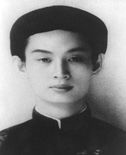PHẬT GIÁO HÒA HẢO
HARMONY BUDDHISM
Hồng Lạc
Hong-Lac: a combination of the Heirdom ‘Hồng Bàng’ by the founding ancestor of Hung Kings who proclaimed ‘King Duong Vuong, and called his newborn nation “Xich Quy”, and of Lạc Long Quân, his successor, who founded the Dynasty of Hung Kings.
The first Hùng king (c. 2879 BC)
During a few thousand years in the Late Stone Age, the inhabitant populations grew and spread to every part of Vietnam. Most ancient people were living near the Hồng (Red), Cả and Mã rivers. The Vietnamese tribes were the primary tribes at this time. Their territory included modern meridional territories of China to the banks of the Hồng River in the northern territory of Vietnam. Centuries of developing a civilization and economy based on the cultivation of irrigated rice encouraged the development of tribal states and communal settlements.
Early Hồng Bàng (c. 2879 – c. 1913 BC)
As rule was passed to the Hùng king's male heirs, Kinh Dương Vương was succeeded by his son Lạc Long Quân, who founded the second dynasty of Hùng kings in c. 2793 BC.
Starting from the third Hùng dynasty since c. 2524 BC, the kingdom was renamed Văn Lang, and the capital was set up at Phong Châu (in modern Việt Trì, Phú Thọ) at the juncture of three rivers where the Red River Delta begins from the foot of the mountains.
Middle Hồng Bàng (c. 1912 – c. 1055 BC)
By 1500 BC, the coastal residents developed a sophisticated agricultural society. Late Hồng Bàng (c. 1054 – c. 258 BC)
The tidal irrigation of rice fields through an elaborate system of canals and dikes started by the sixth century BC. The Hùng ruler of the Eighteenth Dynasty led the armies to conquer what is modern-day Nghệ An and Hà Tĩnh Provinces. A rival people, the proto-Cham people based in modern-day Quảng Bình Province, resisted and a clash between the two sides was inevitable. The Hùng forces defeated the proto-Chams, annexing the land.
The Hồng Bàng epoch ended in the middle of the third century BC on the advent of the military leader Thục Phán's conquest of Văn Lang, dethroning the last Hùng king in c. 258 BC. After conquering Văn Lang, Thục Phán united the Lạc Việt tribes with the Âu Việt ones to form a new kingdom of Âu Lạc, building his capital and citadel, Cổ Loa Citadel in Hanoi's Dong Anh district.
The Lạc lords maintained their feudal influence long after demise of the Hồng Bàng era. These feudal lords faded into history only after the defeat of the Trưng Sisters in mid 1st-century AD.
Open Wikipedia
Lac Hong is the name of the Vietnamese race of people which appeared in the earliest era of nation-building. It is also called Hồng Lạc, the title of a country which can be traced back to more than 4000 years in history. Hong-Lac: a combination of the Heirdom ‘Hồng Bàng’ by the founding ancestor of Hung Kings who proclaimed ‘King Duong Vuong, and called his newborn nation “Xich Quy”, and of Lạc Long Quân, his successor, who founded the Dynasty of Hung Kings. The first Hùng King (c. 2879 BC) During a few thousand years in the Late Stone Age, the inhabitant populations grew and spread to every part of Vietnam. Most ancient people were living near the Hồng (Red), Cả and Mã rivers. The Vietnamese tribes were the primary tribes at this time. Their territory included modern meridional territories of China to the banks of the Hồng River in the northern territory of Vietnam. Centuries of developing civilization and economy based on the cultivation of irrigated rice encouraged the development of tribal states and communal settlements.
Early Hồng Bàng (c. 2879 – c. 1913 BC) As rule was passed to the Hùng king's male heirs, Kinh Dương Vương was succeeded by his son Lạc Long Quân, who founded the second dynasty of Hùng kings in c. 2793 BC. Starting from the third Hùng dynasty since c. 2524 BC, the kingdom was renamed Văn Lang, and the capital was set up at Phong Châu (in modern Việt Trì, Phú Thọ) at the juncture of three rivers where the Red River Delta begins from the foot of the mountains. Middle Hồng Bàng (c. 1912 – c. 1055 BC) By 1500 BC, the coastal residents developed a sophisticated agricultural society.
Late Hồng Bàng (c. 1054 – c. 258 BC) The tidal irrigation of rice fields through an elaborate system of canals and dikes started by the sixth century BC. The Hùng ruler of the Eighteenth Dynasty led the armies to conquer what is modern-day Nghệ An and Hà Tĩnh Provinces. A rival people, the proto-Cham people based in modern-day Quảng Bình Province, resisted and a clash between the two sides was inevitable. The Hùng forces defeated the proto-Chams, annexing the land. The Hồng Bàng epoch ended in the middle of the third century BC on the advent of the military leader Thục Phán's conquest of Văn Lang, dethroning the last Hùng king in c. 258 BC. After conquering Văn Lang, Thục Phán united the Lạc Việt tribes with the Âu Việt ones to form a new kingdom of Âu Lạc, building his capital and citadel, Cổ Loa Citadel in Hanoi's Dong Anh district. The Lạc lords maintained their feudal influence long after the demise of the Hồng Bàng era. These feudal lords faded into history only after the defeat of the Trưng Sisters in mid-1st-century AD.

